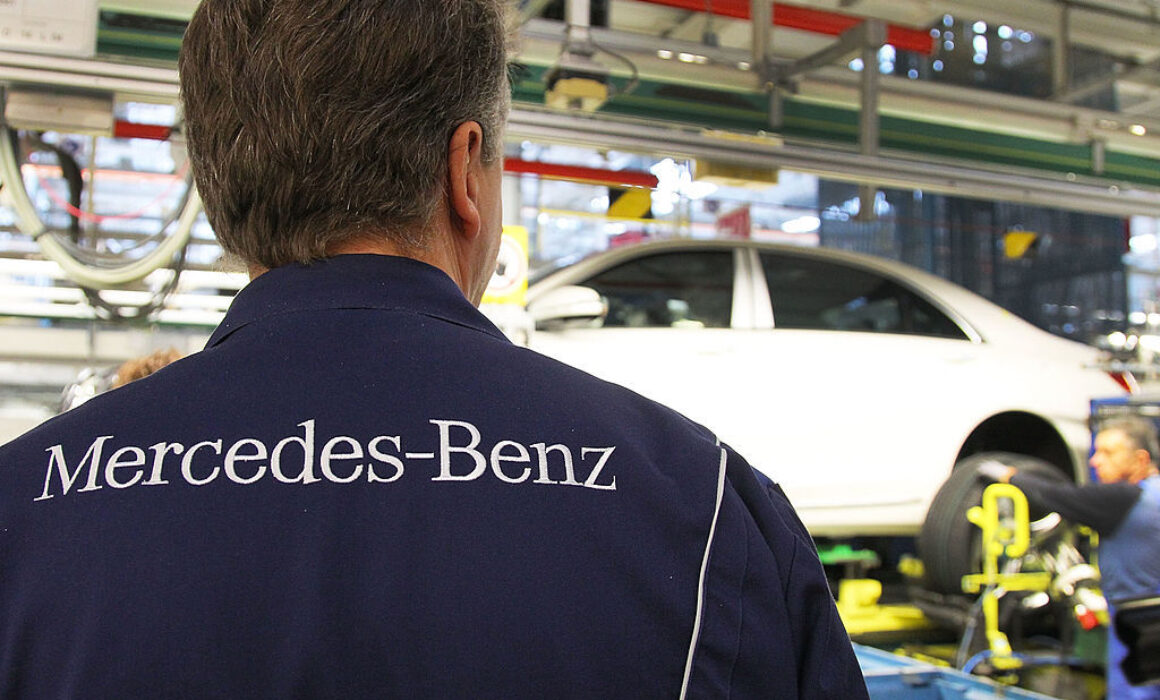They Can’t Keep Getting Away with This: A Second Chance at Mercedes
June 20, 2024
By Diana Reddy, Seth D. Harris
Fireside Stacks is a weekly newsletter from Roosevelt Forward about progressive politics, policy, and economics. We write on the latest with an eye toward the long game. We’re focused on building a new economy that centers economic security, shared prosperity, and rebalanced power.
(Photo by Thomas Niedermueller/Stringer/Getty Images)
Strictly from a numbers perspective, the UAW’s defeat at Alabama’s Mercedes plants in mid-May should have been unexpected. When the UAW petitioned the National Labor Relations Board (NLRB or Board) in early April requesting an election, a supermajority of Mercedes workers said they wanted a union. Yet, by the time the NLRB conducted the election just six weeks later, things had changed drastically. Fifty-six percent of those same workers voted against unionizing. For the time being, the Alabama Mercedes plants will remain the only nonunion Mercedes plants in the entire world.
Unfortunately, the result in Alabama is not an anomaly. It seems like what happened at Mercedes—that so many workers changed their minds so quickly—should be extraordinary, but it is not. Far too many union representation elections are lost in exactly the way Mercedes was lost. Once a company learns its employees want a union (and have the support and momentum to make it happen), the employer engages in a no-holds-barred anti-union campaign. Weeks of surveillance, interrogation, firings, forced meetings, threats, and illegal inducements leave workers confused, fearful, and—worst of all—pessimistic. And some change their minds about the union, opting to go along with the bully who controls their paycheck.
If you’re wondering why such anti-union tactics are legal—why a labor law intended to ameliorate “the inequality of bargaining power” between workers and employers would allow employers to exploit that same power imbalance to deter workers from unionizing in the first place—the short answer is: Most of them aren’t.
Although American labor law has never been as protective of workers’ rights as the laws of most wealthy democracies, it nevertheless recognizes employers’ coercive power over employees and prohibits its worst excesses, particularly when an election is on the horizon. Yet, anti-union employers regularly violate the law during elections. They break the law because their tactics are remarkably effective at defeating unionization and because, in recent decades, the NLRB has struggled to figure out how to stop them.
According to the UAW, Mercedes flagrantly violated the law in the run-up to their election, from firing union supporters, including one worker with stage four cancer, to promising $7,000 bonuses to workers, while tacitly suggesting that those bonuses might not be available if the union won.
Although union-busting and violating labor laws occurs all across our country, the politics and culture of the American South contributed to the organizing defeat at Mercedes. Conservative Southern politicians have long insisted that the South is un-organizable, and they have done everything they can to make it so.
When the National Labor Relations Act (NLRA) was enacted in 1935, elite, white Southern politicians fought to preserve Jim Crow by insisting that agricultural and domestic workers be excluded. This ensured that unionization would be unavailable for most workers, particularly Black workers, in the largely agrarian South for decades. After the enactment of the Taft-Hartley Act’s amendments to the NLRA in 1947, elite, white Southern politicians quickly declared their states “right-to-work,” making unionization much more difficult for Southern workers. When the governors of six Southern states spoke out against the UAW’s campaign at the Mercedes plants, they drew on this legacy; and by proclaiming it, they continued the process of recreating it.
What Mercedes is alleged to have done to overwhelm the will of its employees should be shocking—we should be shocked, you should be shocked—but no one is shocked. The extraordinary reality is that industrial lawlessness has become entirely ordinary in union elections, especially but not exclusively in the American South. But it was not always this way, and it does not have to stay this way.
The Mercedes losses this May were not inevitable; rather, they were made possible by what politicians, policymakers, and even unions themselves have chosen to do, or not do, over time.
The South’s anti-unionism and suppression of workers’ rights was powered by a desire to sustain racial and class hierarchies established during the era of slavery. Then, in the 1980s, the modern era of anti-union tactics went national. When President Ronald Reagan fired striking air traffic controllers in 1981, he also legitimized what had previously been seen as largely unacceptable post-NLRA in most of the country: destroying unions and union organizing efforts.
As anti-unionism went mainstream, it became more sophisticated and more effective. A cottage industry of union avoidance consultants and lawyers sprung up, creating a literal playbook for the psychological coercion and intimidation of workers. These tactics have undermined labor law’s promise of industrial democracy.
In 1995, researchers with the Economic Policy Institute concluded that the remarkable 37 percent difference in union election win rates in the public and private sectors—unions were winning 85 percent of public sector elections, but only 49 percent in the private sector—was almost entirely attributable to employer opposition. Public employers often stayed neutral when employees sought to unionize, while private-sector employers were “significantly more aggressive.” And this changed the outcome of elections.
While some of what employers do to resist unionization is unfortunately legal, much of it is not. Employers regularly engage in unfair labor practices (ULPs, i.e., violations of federal private sector labor law) to undermine union organizing.
The UAW contends that, consistent with the employer anti-union playbook, Mercedes committed numerous ULPs during its organizing campaign. Like their captive audience meetings, Mercedes’s allegedly illegal conduct has become all too ordinary in American labor relations: appeals to racial prejudice, promises of future benefits if workers voted “no,” firing UAW supporters, and retaliating against pro-UAW employees using drug tests, among others. These violations happen all the time. The only way to change the trajectory of regularized employer illegality during organizing drives is to impose a meaningful remedy.
Unfortunately, under current law, the NLRB’s remedial authority is remarkably weak, and employers take advantage of it. The NLRB cannot award punitive or compensatory damages, or impose statutory fines. For the more egregious violations, all the Board can do is make the individual worker whose rights have been violated whole, and even then, this has often meant only whole as to the harms they suffer within the workplace (the current NLRB has broadened this approach, though).
The Board may also order a new election to try to undo the harm to the union, but employer intimidation and coercion are hard bells to un-ring. Since firing a union organizer can stop a union campaign in its tracks, no matter how many times an election is re-run, this kind of remedy is largely ineffective in deterring violations: For the committed anti-union employer, it makes economic sense to violate the law. Then, if they happen to be caught and held to account, they pay the remedy as a cost of doing business.
This effect is exacerbated in the South. When making its decision about where to site its American facility, Mercedes focused its search on the American South keenly aware of its right-to-work laws and powerful anti-union culture and politics. Mercedes has extensive experience bargaining and working with unions in Germany. Yet, in the United States, Mercedes wanted its facility nestled in the arms of the strictly anti-union, low-wage culture and political climate that the American South offers employers.
Enter: The Bargaining Order
As noted above, the NLRA is notoriously feckless when it comes to penalizing lawbreaking employers. The few remedies the Board can impose—“make whole” remedies, re-run elections, and notice postings—are narrowly focused on harms to individuals and simply do not deter employer unlawful conduct. The standard story has been that the NLRB cannot do any more consistent with its statutory authority. This is not true.
The NLRB has long employed a remedy that, when used consistently, is remarkably effective in deterring employer unfair labor practices: The bargaining order.
Bargaining orders require employers to bargain with a union when an employer’s illegal actions have intimidated and coerced enough workers to cost the union its majority support. Historically, the NLRB imposed these orders as frequently as employers made them necessary, as the best possible mechanism for incentivizing employers to behave lawfully. Today, when an employer commits ULPs that cause a union to lose an election, it ends up—at the absolute worst—exactly where it would have been otherwise, perhaps facing a new election. But with a bargaining order, the lawbreaking employer instead ends up in its worst-case scenario: compelled by the Board to recognize and bargain with a union.
This is a remedy, then, that truly deters unlawful behavior. Unfortunately, the bargaining order fell into disuse decades back. It has been reserved only for cases involving the most “egregious” unfair labor practices. That standard became increasingly difficult to meet as employers’ baseline behavior became more and more egregious.
Yet, the Board recently issued a decision that could return the bargaining order to its rightful remedial role. In Cemex Construction Materials Pacific, LLC, the Board held that it may order an employer to bargain with a union even if that union has not won an election among its employees, if the employer commits ULPs that cause workers who support the union to abandon that support and the union loses its majority.
Under Cemex, the bargaining order is not reserved for only the worst of the worst ULPs; nor does it require workers to prove the metaphysically unprovable—that any new election would necessarily be tainted. Under Cemex, the emphasis is on rational governance: incentivizing everyone to do things right the first time or face meaningful consequences.
Is a Cemex bargaining order appropriate in a case like Mercedes? Again, at Mercedes, the unfair labor practices were both ordinary, as in run-of-the-mill, and extraordinary, as in horribly destructive to the purposes of labor law. In addition to firing UAW supporters and other violations, Mercedes replaced its US CEO and promised workers benefits in a union-free future. While the Board would have to investigate further, it seems quite likely that this kind of intimidation, coercion, and promise of future benefits played an important role in changing some employees’ support for the union into opposition and turned a pro-union supermajority into an election loss.
History suggests that industrial lawlessness will prevail until and unless employers are forced to face consequences for their transgressions. This Board has shown that it wants to take law enforcement seriously. What should taking the law seriously mean at Mercedes?
The UAW has not yet requested a Cemex bargaining order from the Board as a remedy for the multiple ULPs it has alleged. For now, it has only sought a new election. The union’s decision likely reflects how central “the election” has become to union legitimacy in the region. In the run-up to the Mercedes vote, the National Right to Work Foundation peppered the airways with arguments about how the UAW would eventually use its supermajority to avoid the Board’s election process, thereby allegedly denying workers the chance to really have a voice. The UAW refrained and plowed ahead with its campaign even as Mercedes made it clear that it would not play fairly.
At a bare minimum, the Board should grant the UAW’s request for a new election. But we have seen this movie with an Alabama backdrop before. In Bessemer, the Retail, Wholesale and Department Store Union (RWDSU) lost an election among Amazon warehouse employees in 2021 and succeeded in forcing a new election in 2022. The election is still not resolved more than two years later. Alabama will remain Alabama unless the Board imposes a change.
This remains an extraordinary moment for American workers. A decade of rising public support for unions has grown into an organizing boom, including in industries, companies, and states where it long seemed impossible—from Amazon warehouses to Starbucks coffee shops to Southern automotive plants. The loss at Mercedes should not take away from how much has already been won or from all the opportunities ahead.
That said, the loss at Mercedes is an essential reminder that momentum alone will not carry the day. For decades, American labor law has made a promise to workers that it has not kept. Our law purports to offer “full freedom of association” and “actual liberty of contract” to working people—the ability to have a real voice in their working lives, to lift themselves up, and to lift the rest of us up along with them. But the inequalities of bargaining power that make unions necessary also make it unconscionably difficult to form them, especially when faced with full-fledged employer opposition. There are a host of reasons why labor law has not worked for workers in recent decades. But one of the major ones is the failure to actually enforce the law—whether in letter or in spirit—in the South.
Read Seth and Diana’s full analysis of the UAW-Mercedes campaign at Power at Work.
If You Ask Eleanor
“Unions have been established as a protection to labor, and without the protection of the union, even non-unionized labor probably would have a much harder time, since the gains made for labor all have been achieved through the efforts of unions. No one man alone has any strength, but when he is joined in a union, he is able to make advances and obtain things for his membership.”
– Eleanor Roosevelt, My Day (September 22, 1956)
Authors
Diana Reddy
Diana Reddy is an assistant professor at the UC Berkeley School of Law and a fellow at the Roosevelt Institute. Her research focuses on the regulation of work as a site where critical choices are made about the relationship between American economic commitments and its democratic ideals. Before becoming a professor, Diana represented labor unions and workers at the AFL-CIO, Altshuler Berzon LLP, and the California Teachers Association. Diana holds a PhD from Berkeley, a JD from NYU, and an MA from Stanford University.
Seth D. Harris
Seth D. Harris is a Distinguished Professor of Practice at Northeastern University and Affiliated Faculty and a Senior Fellow at the Burnes Center for Social Change (and its partner project The GovLab) where he runs the Initiative on Labor and Economic Justice. Prior to joining Northeastern University, Professor Harris was the Deputy Assistant to the President for Labor and the Economy and Deputy Director of the Biden White House’s National Economic Council.




